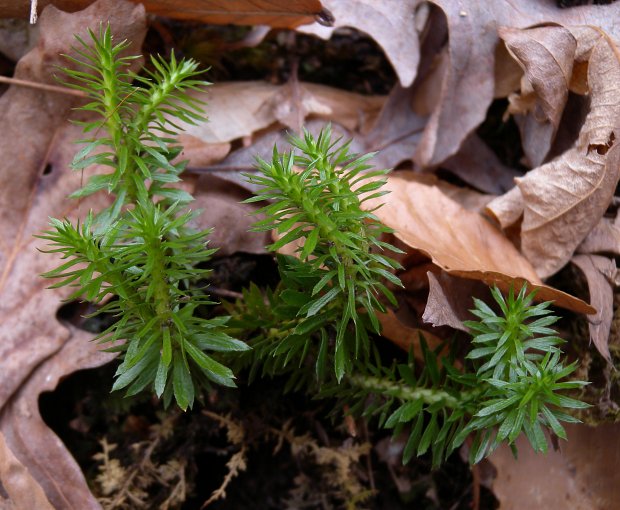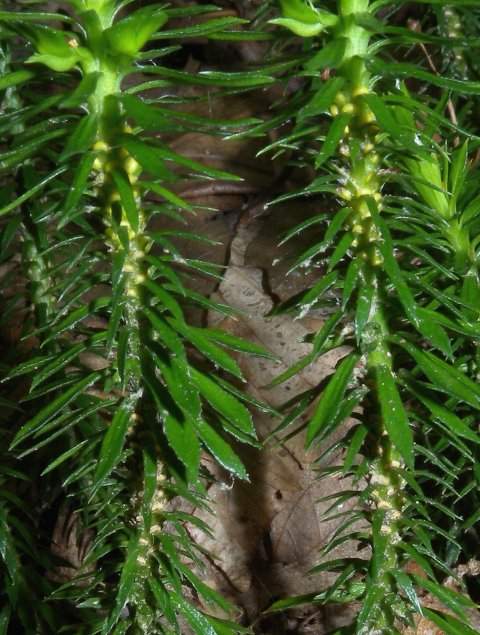
The spores are released during the autumn, when they are distributed by the wind. By the end of summer, there are often small gemmae (plantlet-buds) at the apices of leafy stems. These gemmae are arranged in a short pseudowhorl on each leafy stem. The gemmae are up to 6 mm. long, 6 mm. across, and green. During the autumn, after the gemmae become detached from the stems, they are distributed to a limited extent by wind or water. After contacting moist ground, the gemmae are able to develop fibrous roots, establishing new clonal plants. The decumbent stems of mature plants also develop fibrous roots when they establish contact with moist ground.
Cultivation: This plant prefers dappled sunlight to medium shade, moist to dry-mesic conditions, and an acidic soil that contains some decaying organic matter. It is typically surrounded by a protective layer of leaf litter. Development from spores is a very slow process that takes several years to complete and it requires the presence of appropriate soil fungi. It is easier to propagate new plants by using the gemmae (plantlet-buds) of mature plants.

Range & Habitat: The native Shining Firmoss is widely scattered in Illinois, where it is rare (see Distribution Map). Because of its small size and resemblance to some kinds of true moss, this plant may be overlooked and it could be more common than current records indicate. Habitats include rocky woodlands, wooded hillsides, rocky wooded canyons, sandstone ledges and boulders, forested bogs, and shaded ravines. This plant can be found in deciduous woodlands, mixed woodlands, and coniferous woodlands. It is associated with higher quality natural areas.
Faunal Associations: Information about floral-faunal relationships for this plant are unavailable at the present time. However, the value of this small plant to wildlife appears to be low. The foliage of plants in the Clubmoss family is often toxic.
Photographic Location: A rocky hillsides at the Portland Arch Nature Preserve and Shades State Park in west-central Indiana.

Comments: Species of the clubmoss family (Lycopodiaceae) derive from some of the oldest vascular plants on Earth. Tree-size specimens of clubmoss occurred during the Carboniferous era, forming part of the coal fields that are used today as a source of energy. However, modern species of clubmoss are small plants. Shining Firmoss (Huperzia lucidula) can be easily confused with a non-vascular moss, however it is quite distinct from true mosses. It tends to be larger in size than many similar mosses, and the texture of its foliage is more firm. Another species that is similar in appearance to Shining Firmoss is Cliff Firmoss (Huperzia porophila). This latter species differs by having leaves that are widest at the base, leaf margins that are always entire (smooth), and it has stomata (air pores) on both the upper and lower sides of its leaves (visible with 20x magnification). This species is typically found in such rocky habitats as sandstone ledges, mossy boulders, and shaded rocky ravines. While Shining Firmoss occasionally occurs in such habitats, it is more common on the forest floor, surrounded by leaf litter. Another species with a similar appearance, Rock Spikemoss (Selaginella rupestris), differs by having ascending leaves that are widest at their bases, while the tips of its leaves are needle-like and whitish. Spikemosses differ from clubmosses by producing two kinds of spores: larger macrospores (female) and smaller microspores (male). In contrast, the spores of clubmosses are the same size. An older scientific name for Shining Firmoss is Lycopodium lucidulum. Another common name of this plant is Shining Clubmoss.